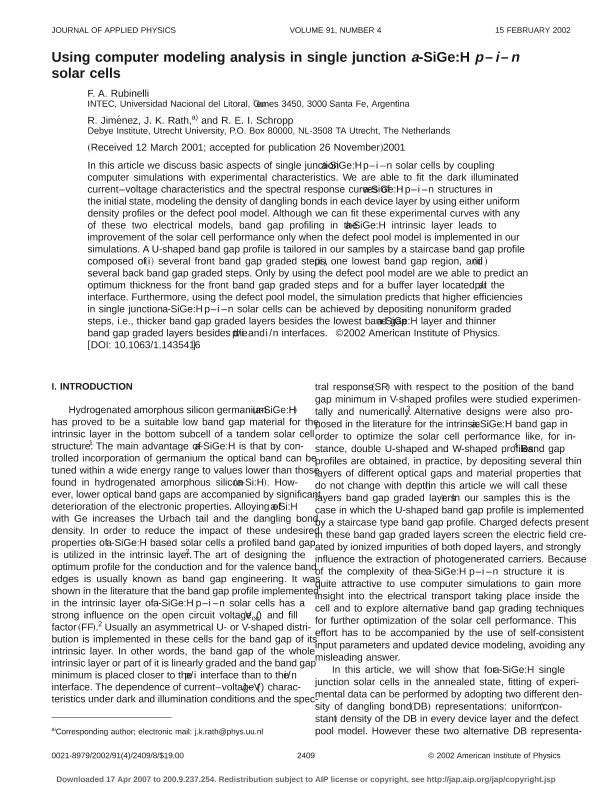Mostrar el registro sencillo del ítem
dc.contributor.author
Rubinelli, Francisco Alberto

dc.contributor.author
Jiménez, R.J.
dc.contributor.author
Rath, J.K.
dc.contributor.author
Schropp, R.E.I.
dc.date.available
2017-12-10T16:19:21Z
dc.date.issued
2002-02
dc.identifier.citation
Rubinelli, Francisco Alberto; Jiménez, R.J.; Rath, J.K.; Schropp, R.E.I.; Using computer modeling analysis in single a-SiGe:H p-i-n solar cells; American Institute of Physics; Journal of Applied Physics; 91; 2-2002; 2409-2416
dc.identifier.issn
0021-8979
dc.identifier.uri
http://hdl.handle.net/11336/30071
dc.description.abstract
In this article we discuss basic aspects of single junction a-SiGe:H p–i–n solar cells by coupling computer simulations with experimental characteristics. We are able to fit the dark illuminated current–voltage characteristics and the spectral response curves of a-SiGe:H p–i–n structures in the initial state, modeling the density of dangling bonds in each device layer by using either uniform density profiles or the defect pool model. Although we can fit these experimental curves with any of these two electrical models, band gap profiling in the a-SiGe:H intrinsic layer leads to improvement of the solar cell performance only when the defect pool model is implemented in our simulations. A U-shaped band gap profile is tailored in our samples by a staircase band gap profile composed of (i) several front band gap graded steps, (ii) one lowest band gap region, and (iii) several back band gap graded steps. Only by using the defect pool model are we able to predict an optimum thickness for the front band gap graded steps and for a buffer layer located at the p/i interface. Furthermore, using the defect pool model, the simulation predicts that higher efficiencies in single junction a-SiGe:H p–i–n solar cells can be achieved by depositing nonuniform graded steps, i.e., thicker band gap graded layers besides the lowest band gap a-SiGe:H layer and thinner band gap graded layers besides the p/i and i/n interfaces.
dc.format
application/pdf
dc.language.iso
eng
dc.publisher
American Institute of Physics

dc.rights
info:eu-repo/semantics/openAccess
dc.rights.uri
https://creativecommons.org/licenses/by-nc-sa/2.5/ar/
dc.subject
Sige Solar Cells
dc.subject
Bangap Engineering
dc.subject
Modelling
dc.subject
J-V Curves
dc.subject.classification
Ingeniería de Sistemas y Comunicaciones

dc.subject.classification
Ingeniería Eléctrica, Ingeniería Electrónica e Ingeniería de la Información

dc.subject.classification
INGENIERÍAS Y TECNOLOGÍAS

dc.title
Using computer modeling analysis in single a-SiGe:H p-i-n solar cells
dc.type
info:eu-repo/semantics/article
dc.type
info:ar-repo/semantics/artículo
dc.type
info:eu-repo/semantics/publishedVersion
dc.date.updated
2017-11-24T13:44:22Z
dc.journal.volume
91
dc.journal.pagination
2409-2416
dc.journal.pais
Estados Unidos

dc.journal.ciudad
Newsville, New York
dc.description.fil
Fil: Rubinelli, Francisco Alberto. Consejo Nacional de Investigaciones Científicas y Técnicas. Centro Científico Tecnológico Conicet - Santa Fe. Instituto de Desarrollo Tecnológico para la Industria Química. Universidad Nacional del Litoral. Instituto de Desarrollo Tecnológico para la Industria Química; Argentina
dc.description.fil
Fil: Jiménez, R.J.. Utrecht University; Países Bajos
dc.description.fil
Fil: Rath, J.K.. Utrecht University; Países Bajos
dc.description.fil
Fil: Schropp, R.E.I.. Utrecht University; Países Bajos
dc.journal.title
Journal of Applied Physics

dc.relation.alternativeid
info:eu-repo/semantics/altIdentifier/doi/http://dx.doi.org/10.1063/1.1435416
Archivos asociados
